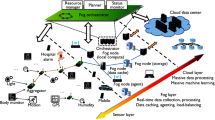Abstract
Lately, inspired by Internet of Things (IoT), the era of connected everything is coming. But still, things hardly show the manner to share resources on it and self-configuration method to compose collaboration of smart things. Moreover, it is not easy to harmonize things of related action with added or removed devices to aid process being conducted by human or services of applications. In this paper, we propose a concept for supporting a collaboration augmentation of devices used in the IoT. The Device-Rank for the augmenting collaboration of things proposed in this paper is a technology used to rate IoT things based on diverse elements such as the frequency with which users use individual things, the distances to users or service objects, the network QoS, the performance of the things, and their operation histories, such that the resultant information can be used by a cloud-based platform or device itself to calculate the Device-Rank information. This Device-Rank is expected to be accumulated and updated by things or a platform, and exchanged between things such that things can more actively collaborate with other things or services and augment the Device-Rank with the passing of time.







Similar content being viewed by others
References
Alljoyn, https://www.alljoyn.org/
CERP-IoT (2010) Cluster of European Research Projects on the Internet of Things: Vision and Challenges for Realizing the Internet of Things, CERP-IoT
Esuli A, Sebastiani F (2007) PageRanking WordNet synsets: An application to opinion mining, In Proc. Association for Computational Linguistics, 424-–431
ETSI, ETSI TS 102 690 v.2.1.1 Machine-to-Machine communication (M2M) (2013) Functional architecture, ETSI
ETSI, ETSI TS 102 921 v.2.1.1 Machine-to-Machine communication (M2M) (2013) mIa, dIa and mId interface, ETSI
Gubbia J, Buyyab R, Marusica S (2013) Marimuthu Palaniswamia.: Internet of Things (IoT): A vision, architectural elements, and future directions. Futur Gener Comput Syst 29(7):1645–1660
Guo B et al (2012) Opportunistic IoT: Exploring the Social Side of the Internet of Things, Proc. of the 16th IEEE International Conference on Computer Supported Cooperative Work in Design (CSCWD’12), Wuhan, China, 925—929
If This Then That, https://ifttt.com/
ITU Internet Reports (2005) The Internet of Things, ITU
Kang HJ, Kim MK, Bae MN, Bang HC (2013) Design of Media measurement and monitoring system based on Internet of Things. Proceeding of the 4th International Conference on Security-enriched Urban Computing and Smart Grid
Kim Chang S, Tseng A, Zhixian Xiang M (2011) Global wireless machine-to-machine standardization. IEEE Internet Comput 15(2):64–69
Kim M, Bang HC (2013) Ad Hoc Things Collaboration Based on Semantics of Things, Proceedings of the 2013 International Conference on Systems, Control and Informatics, 69—72
Kleinberg JM (2009) Authoritative sources in a hyperlinked environment. J ACM (JACM) 46(5):604–632
Lee BM, Ouyang J (2014) Intelligent healthcare service by using collaborations between IoT personal health devices. Int J Bio-Sci Bio-Technol 6(1):155–164
Miorandi D, Sicari S, Pellegrini F, Chlamtac I (2012) Internet of things: vision, applications and research challenges. J Ad Hoc Networks 10(7):1497–1516
Mohamed MA, Xiao W (2007) Q-metrics: An efficient formulation of normalized distance functions, ISIC. IEEE, 2108—2113
Motoyama M et al (2010) Measuring online service availability using twitter, Workshop on online social networks, Boston, Massachusetts, USA
Nurmi H (2004) A comparison of some distance-based choice rules in ranking environments, Theory and Decision, Springer, 5—24
Page L, Brin S, Motwani R, Winograd T (1998) The pagerank citation ranking: bringing order to the web, Stanford Digital Libraries Working Paper
Philips Hue, http://www.meethue.com/
Pyo Chul Sik (2013) M2M Techonolgy and Its Standardization Trends, oneM2M 2013 Seoul International Conference
Stankovic JA (2008) When sensor and actuator networks cover the world. ETRI J 30(5):627–633
Tan K-L, Mustapha SMFDS (2006) Measuring availability of mobile Web services, proc. Int’l conf. Semantic Web & Web services (SWWS 2006). CSREA Press, Las Vegas, pp 87–93
Tarazona Bermudez, Espada, Nunez-Valdez (2013) Using collaborative virtual objects based on services to communicate smart objects, proceeding of the Seventh International Conference on Innovative Mobile and Internet Services in Ubiquitous Computing, 456—461
Villafuerte FL, Terfloth K, Schiller J (2008) Using network density as a new parameter to estimate distance, ICN2008, 30—35
Yoo SK, Hong YG, Kim HJ (2011) Smart mobile services – M2M technology and its standardization trends. Ettrend 26(2):50–60
Yoon CW et al (2010) Dynamic collaborative cloud service platform: opportunities and challenges. ETRI J 32(4):634–637
Zheng VW, et al (2010) Collaborative location and activity recommendations with gps history data, Proceedings of the 19th international conference on World Wide Web, 1029—1038
Acknowledgements
This work was supported by Electronics and Telecommunications Research Institute (ETRI) grant funded by the Korea government [15ZC1310, Development of USN/WoT Convergence Platform for Internet of Reality Service Provision].
Author information
Authors and Affiliations
Corresponding author
Rights and permissions
About this article
Cite this article
Kang, H., Kim, M., Bae, M. et al. A conceptual device-rank based resource sharing and collaboration of smart things. Multimed Tools Appl 75, 14569–14581 (2016). https://doi.org/10.1007/s11042-015-2830-z
Received:
Revised:
Accepted:
Published:
Issue Date:
DOI: https://doi.org/10.1007/s11042-015-2830-z




